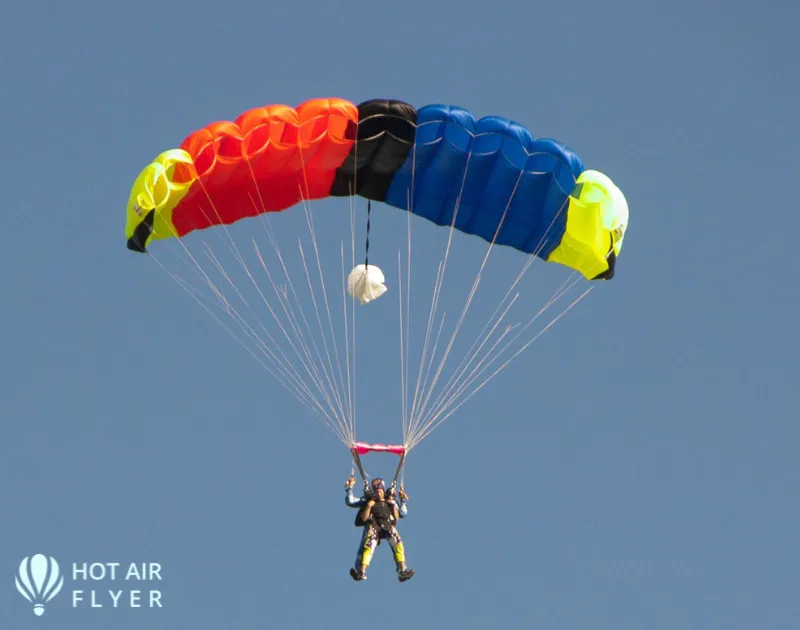When you’re hundreds or thousands of feet in the air like you are when hot air ballooning, you always want to be prepared for the worst-case situation.
Will the balloon pilot have parachutes with which you can land if the balloon fails?
Parachutes are not carried by hot air balloons since they are unnecessary.

The balloon pilot will always check that the burner system has enough fuel to complete the journey.
If one or both burners fail and the balloon is unable to maintain flight, the wind within the hot air balloon will act as a parachute, guiding you to the earth.
Having an emergency parachute on board a hot air balloon, while it may seem like a smart idea, is not standard operating procedure.
Fans of hot air balloons scoff at the idea of a parachute, but anyone who has ever boarded a flight has a real question.
The Federal Aviation Administration (FAA) mandates that balloons carry authorized flotation devices, although these are just for water buoyancy, not for landing.
A parachute, in fact, would not be able to halt the hot air balloon’s ascension enough to prevent harm or death due to its natural tendency to climb.
They also don’t need a parachute because it’s impossible for a hot air balloon to crash from such high heights, and the existence of one would just complicate the launch and landing.
Is it Possible to Parachute Out of a Hot Air Balloon?
Parachuting from a hot air balloon has been a fringe hobby for daredevils for decades.
But, with recent technology advancements, the sport is becoming more mainstream, and an increasing number of people are traveling to the skies to experience the excitement of skydiving without having to leap out of a plane.

While the novelty of leaping from a hot air balloon is the primary motivation for doing so, the safety benefits are substantial.
Hot air balloons are less sensitive to turbulence and other harmful air currents since they fly at a lower height than airplanes.
Because of the lower altitude, parachute jumps from a hot air balloon are less likely to cause injury or death.
Unless you’re skydiving out of a hot air balloon, there’s no need to carry a parachute. It’s not a requirement by hot air ballooning companies across the United States either.
Why? There’s just no need for a parachute.
What if there’s no more fuel left onboard, you ask? Then the balloon captain would look for a place to make a sudden but safe landing.
Maybe you’re not concerned so much about the hot air balloon running out of fuel, but the burner system failing. If your balloon has a single-burner system, then all it takes is that one burner going down.
Even in a two-burner system, the failure of one burner could still be disastrous.
To make things a little safer, parachutists wear specially made suits that allow them to free fall from the balloon before launching their chutes.
The concept of parachuting from a hot air balloon may seem insane to most people, but those who are looking for a means to leap out of a balloon can relax.
Despite how unlikely it may appear, there are solutions to make this transition.
The first step is to locate a hot air balloon and a pilot willing to accompany you on your adventure. To transport passengers, the pilot will need an FAA license.
If you wanted to parachute from a hot air balloon, there are a few things to think about in terms of safety.
To begin, where would you land?
You’d be fine if you were lucky enough to land somewhere with a somewhat level surface and no wind.
The main problem would be time; if you jumped too soon, you’d end up in the middle of a lake, but if you leapt too late, you’d land on the ground.
What is the Best Method for Jumping out of a Hot Air Balloon?
“How do I parachute from a hot air balloon?” is the most often question pilots are asked.
“It’s not as simple as it appears,” says the answer.

There are a variety of techniques to parachute from a hot air balloon, each with its own merits.
You could, for example, jump out of the basket while wearing a parachute, much like a skydiver.
The only distinction is that you’d have to be tethered to a rope that was attached to the basket.
Do you want to jump out of a hot air balloon? There are a few things you should know before jumping.
Your Parachute
First and foremost, let’s discuss the parachute that is included with every hot air balloon journey.
It’s a little parachute that’s meant to slow your drop to the ground rather than completely stop you.
It should be loose-fitting, but if it’s too big, don’t worry about it.
Because these parachutes are designed to be worn over the shoulders and under the arms, they should hang lightly and comfortably.
Pulling the line on your parachute as soon as you jump is the safest way to parachute from a hot air balloon.
You’ll have plenty of time to land safely this way.
This is a superb opportunity to obtain a bird’s eye view of the city and is suitable for people of all ages.
However, before you begin packing your parachute into your basket, think about the ideal way to parachute from a balloon.
Parachuting from a hot air balloon is a risky sport that should only be attempted by experienced skydivers.
It is not advised for individuals who have never jumped out of a plane before.
This could be due to the fact that you require a great deal of experience as well as knowledge of how your body functions and what it is capable of.
People have died as a result of jumping from hot air balloons.
Parachuting Techniques
The ideal technique to parachute from a hot air balloon is to have a lot of practice and a lot of experience with parachuting.
It’s not uncommon for hot air balloons to reach heights of 2,500 feet. At that height, it’s logical that you’d want to prepare for the worst-case scenario – a hot air balloon you are occupying hurtling towards the ground with you glued to one side of the balloon basket in fear.

You imagined that scenario and you’d pack a parachute to wear on your back and deploy if you had to abandon ship if the balloon malfunctions.
Whatever your reservations about hot air ballooning, those situations are quite unlikely to occur.
If you’re concerned that the balloon will run out of propane, rest assured that the balloon pilot will not allow it to happen.
They will keep an eye on a fuel gauge throughout your trip to see if the burner system is running short on fuel.
If the burners run out of fuel, the balloon pilot simply refills them.
What if there’s no more fuel onboard, you might wonder if the balloon captain would then hunt for a spot where he could make a quick but secure landing.
Perhaps you’re more afraid about the burner system failing than the hot air balloon running out of fuel.
If your balloon is equipped with a single-burner setup, all it takes is for that one burner to go out.
Even in a two-burner setup, a single burner failure might be fatal.
What if Scenarios
Let’s go over some what-if scenarios so you can see what could happen. The hot air balloon burner system has entirely failed in this case. The balloon pilot tries to fix it, but the burners aren’t working again.
Because the burners produce the hot air that gives you lift and buoyancy, effectively allowing you to fly, you’ll start falling if you don’t use them.

For a slow landing, the balloon pilot normally vents the hot air through the balloon or occasionally turns the blast valve (which supplies propane to the burner system) off and on.
The hot air balloon burner system has entirely failed.
In this case, isn’t it true that the balloon pilot has no control over your landing speed because there isn’t a burner system?
Wrong! If you start falling, the hot air balloon will function as a parachute and guide the balloon to safety.
The landing might be a little startling if it’s a particularly windy day, but you shouldn’t be ballooning on a windy day in the first place, so that’s unlikely to be an issue.
You’ll descend at the same speed as if you were parachuting from that height with the balloon acting as a parachute.
The drop rate is approximately 17 feet per second, or 4.77 miles per hour.
Given that hot air balloons travel at a pace of 5 miles per hour, you wouldn’t notice much of a difference between typical ballooning and landing if all of the balloon’s components failed.
I’m Annie, a twenty-something year old girl who loves hot air balloons. So much so, that I have a full time job as a Flight Instructor and it is all I love talking about. Something about being up there in the elevated altitudes helps all my stresses float away!